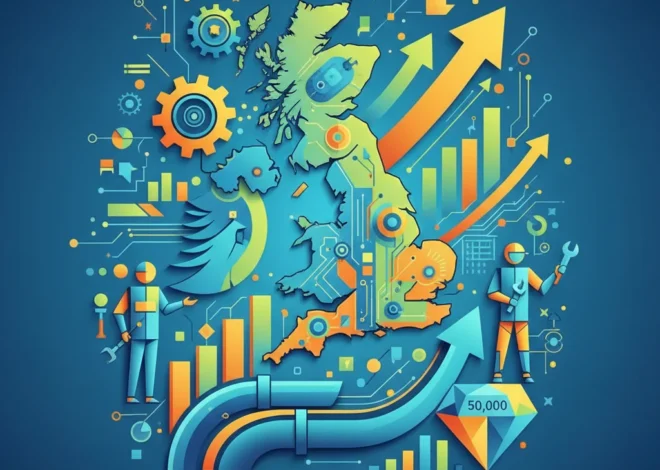
Beyond the Shopping Cart: What Gold, Tech, and a Sunny Summer Tell Us About the Real Economy
In the complex theater of modern economics, the monthly retail sales report often plays a leading role. It’s a tangible, real-time pulse check on consumer confidence, spending power, and the overall health of the economy. While headlines can be deceiving, the latest data reveals a fascinating and deeply nuanced story—one that goes far beyond simple transactions. It’s a narrative of divergence, where sunny weather can spark a fashion spree while grocery aisles remain subdued, and where anxieties about the future drive consumers towards both tangible gold and intangible high-end technology. For investors, business leaders, and anyone interested in the intricate dance of finance, these figures are more than just numbers; they are a roadmap to understanding the powerful cross-currents shaping our economic landscape.
The recent report from the Office for National Statistics (ONS) paints a picture of a resilient, yet fractured, consumer base. While overall sales figures showed strength, the devil is, as always, in the details. The data indicates that while essential spending on food saw minimal growth, a stretch of good weather in July and August provided a significant boost to clothing sales. However, the real story lies in the less-obvious drivers: a surge in sales of jewelry, precious metals, and cutting-edge technology. This bifurcation in spending habits offers a critical window into consumer psychology and the broader economic pressures at play.
Unpacking the Retail Data: A Tale of Two Consumers
To truly grasp the implications, we must dissect the performance across different retail sectors. The headline number can mask underlying weaknesses or disproportionate strengths. The recent data suggests a clear split between necessity, discretionary spending, and long-term value purchases.
Here is a simplified breakdown of the key performing sectors based on recent trends:
| Retail Sector | Performance Trend | Primary Drivers & Economic Indicators |
|---|---|---|
| Food & Grocery Stores | Stagnant / Low Growth | High inflation, cost-of-living pressures, shift to discount brands, reduced volumes. |
| Clothing & Footwear | Strong Growth (Seasonal) | Favorable weather, pent-up demand for seasonal items, social events. |
| Jewelry & Precious Metals (Gold) | Significant Growth | Inflation hedging, economic uncertainty, safe-haven investing, flight to tangible assets. |
| Technology & Electronics | Strong Growth | New product launches, “premiumization” trend, integration of financial technology (Fintech) like BNPL. |
This table illustrates a critical theme: consumers are making calculated choices. They may be cutting back on the volume of their weekly groceries, but they are willing to allocate significant funds to assets they perceive as holding long-term value (gold) or providing high utility and status (the latest smartphone). This is a vital piece of intelligence for anyone involved in the **stock market**, as it signals which corporate sectors are likely to demonstrate resilience.
London's Blueprint for a Building Boom: What Planning Reform Means for the UK Economy and Investors
The Psychology of Spending: Inflation, Weather, and Uncertainty
Why are we seeing this dramatic split? The answer lies at the intersection of **economics** and human psychology.
1. The Food Stagnation: A Barometer of Financial Strain
The lackluster performance of food stores is perhaps the most telling indicator of widespread financial pressure. When spending in this non-discretionary category flattens, it suggests consumers are reaching a limit. They are actively trading down to cheaper alternatives, buying less, and fighting the bite of inflation at every turn. For the central **banking** authorities, this is a crucial signal that their monetary policy is impacting household budgets, even if other parts of the economy appear robust.
2. The Weather-Fueled Fashion Boom: A Fleeting Moment
The boost in clothing sales, while positive, must be viewed with caution. As the ONS data suggests, this was largely driven by external factors like good weather. While it demonstrates that consumers have the capacity and willingness to spend when motivated, it’s a form of discretionary spending that can vanish as quickly as the sunshine. Investors engaged in short-term **trading** might capitalize on these trends, but long-term strategists will see it as a volatile and unreliable indicator of sustainable economic health.
3. The Flight to Safety and Status: Gold and Tech
This is where the story becomes most compelling for those in **finance** and **investing**. The surge in spending on gold and high-end tech reveals a deeper, more complex consumer mindset.
- Gold as a Hedge: In times of high inflation and geopolitical uncertainty, gold has historically been a safe-haven asset. The increase in its retail sales is not just about buying jewelry; it’s about ordinary people making a strategic financial decision to protect their wealth from currency devaluation. It’s a grassroots vote of no confidence in the short-term economic outlook.
- The “Premiumization” of Tech: Simultaneously, the strong demand for premium electronics points to a different kind of value calculation. Consumers may forgo small daily luxuries but will invest in a high-quality device that is central to their work, social life, and entertainment. This trend is often facilitated by modern **financial technology**, with “Buy Now, Pay Later” (BNPL) services making high-ticket items more accessible and blurring the lines between consumption and financing.
Implications for the Broader Financial Ecosystem
These retail trends send powerful ripples across the entire financial world, impacting everything from investment strategies to monetary policy.
For Investors and the Stock Market
The key takeaway is the need for surgical precision. A broad-based retail ETF might not capture the nuances of the current market. Instead, savvy investors should be asking targeted questions:
- Which luxury and tech brands have the pricing power to thrive in a “premiumization” environment?
- Which discount retailers are best positioned to capture the spending of cost-conscious consumers?
- How will commodity-linked equities, particularly those in precious metals, perform if the flight to safety continues?
Understanding this consumer divide is essential for successful portfolio allocation in the current **economy**. Deeper analysis of ONS reports can provide a competitive edge.
Beyond the Pint: An Investor's Analysis of the Pub Industry's Economic Crossroads
For Business Leaders
For businesses, this data is a call to action. Companies must understand which segment of the “K” they serve. Luxury brands can lean into the “investment value” of their products, while essentials-focused businesses must compete fiercely on price and value. Supply chain management also comes into focus. The transparency and provenance of high-value goods like gold and diamonds are increasingly important, a domain where emerging technologies like **blockchain** promise to one day offer revolutionary solutions by creating immutable records of an item’s journey from source to sale.
For Banking and Monetary Policy
Central banks face a conundrum. The strong spending on discretionary goods could be interpreted as a sign that the economy is running hot, justifying higher interest rates to tame inflation. However, the weakness in essential sectors like food tells a different story of consumer strain. This conflicting data makes the job of setting monetary policy exceptionally difficult, increasing the risk of either acting too aggressively and triggering a recession or not acting decisively enough and allowing inflation to remain entrenched.
The Heart's High-Risk Investment: When Emotional Bonds Become Financial Black Holes
Conclusion: Reading the Tea Leaves of the Till
The latest retail sales figures are far more than a simple economic update. They are a detailed portrait of a consumer base navigating a complex world of inflation, uncertainty, and technological change. The divergence between spending on everyday necessities and long-term value assets tells a story of caution, aspiration, and strategic financial thinking at the household level.
For anyone involved in **finance**, **investing**, or business strategy, the message is clear: the monolithic consumer is a myth. The future belongs to those who can understand the nuanced, often contradictory, behaviors driving the modern **economy**. By looking past the headlines and analyzing the deeper trends in what we buy and why, we can gain invaluable insight into the challenges and opportunities that lie ahead.


